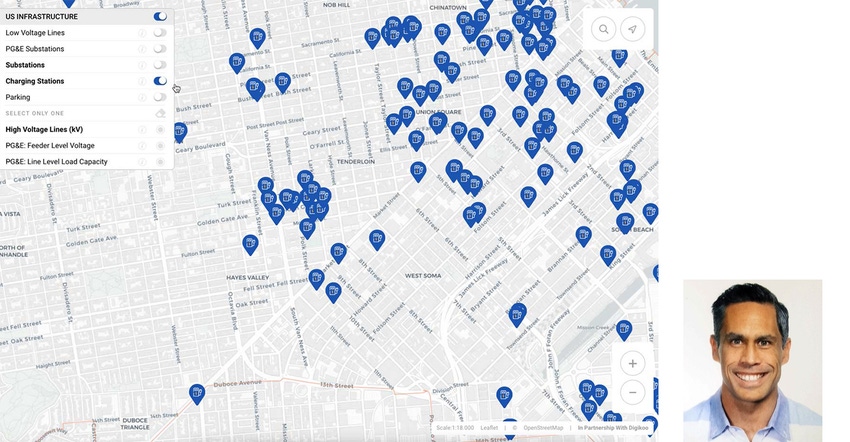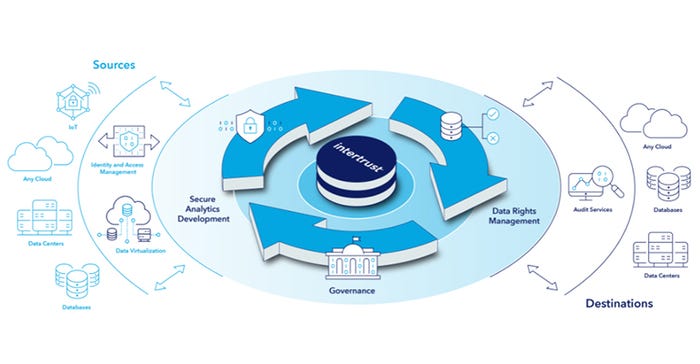What Does a 500,000-Charger EV Network Mean for the Grid?
Half a million EV chargers by 2030 will ask a lot from the grid. Data-based energy-use forecasting is going to be a must as the charging network grows. An Intertrust Technologies data expert explains.

In a widely reported development, Tesla has announced that it will make a minimum of 7,500 of its EV chargers in the United States available to rival EV models by 2024. The move keeps the company—the second-largest network of EV chargers in the US—in line with Biden administration requirements for federal subsidies as it strives to build a national network of half a million chargers.
Meanwhile, GM, Ford and other automakers and companies such as ChargePoint, owner of the largest US charging network, are also expanding their presence in the charging market. The Biden administration also plans to allocate money to individual states from a $5 billion fund over the next five years as it seeks to get to that number of 500,000 chargers—ten times as many as we have now—by 2030.
The idea of having more EV charging stations sounds promising, but as companies and communities rush forward, it makes sense to step back and ask, as many stakeholders do, whether the infrastructure and electric grid will be ready support this electric push.
Behind the charger
When the media talks about charging networks, the discussion is usually accompanied by an image of a car at a charging station or, just as often a tight closeup of a hand holding a charger plug that’s inserted into an EV. (And yes, we’ve done it here plenty of times ourselves.) But you don’t get a sense of the scale of the operation if you’re only looking at its end point—it’s like trying to understand the scale of clean-water delivery systems by looking at a faucet.
To better understand what is going to be required of the energy grid and its infrastructure as a national charging network deploys and grows, we spoke to Chris Kalima, VP, Product Management at Intertrust Technologies, a company specializing in using data to accurately forecast energy demands on the grid. Kalima is able to address questions from a data perspective about the technology needed to aid in EV charging network planning, to help access grid information, and to accelerate the siting and construction of new EV charging stations.
Why is it important to be able to accurately forecast grid-level energy demand? What happens if the forecasts are absent or incorrect?
Intertrust Technologies VP, Product Management Chris Kalima: Forecasting energy demand forecasts is an integral part of any utility’s business and is used in many important ways, both short and long term. Some examples:
Long-term energy demand forecasts help utilities determine where and what size of infrastructure (generators, transmission and distribution lines, transformers, etc.) to build or not to build to meet forecasted demand. It also helps guide contracts utilities may make with other power generators to procure electricity.
Short-term energy demand forecasts help utilities procure the generation they need to maintain power and grid stability over hours and days. For example, if a utility forecasts a spike in power demands at a certain time, they may move to try and procure electricity from other generators who they have connections to or fire up what is known as a “peaker plant” to match demand. Alternatively, they may ask their customers to reduce demand at that time.
How can data help to forecast energy demand?
Kalima: Data forms the backbone of any energy demand forecast and utilities use a wide variety of data sources to do so. For example, data from smart meters help utilities develop a baseline of energy demand and show trends in time. Weather forecast data, both short and long term, helps forecast expected increases in demand for heating and cooling purposes and some utilities run their own networks of weather sensors partly for this reason.
Demographic and economic data is also useful for longer term forecasting based on expected economic and population trends in certain areas. For example, data may show an expected change in one area from primarily light industrial use to high-density housing which will change the energy forecasts for that area.

How does the Intertrust Platform work to enable accurate energy usage forecasting?
Kalima: Intertrust Platform enables accurate energy usage forecasting primarily in 3 ways:
It ensures quick and simple access to data sets. Utilities often hold data in a variety of physical locations and formats and Intertrust Platform makes it simple to query these data sets without physically moving the data, which can be both costly and open up security holes. Utilities may also use third party data for forecasting and Intertrust Platform makes it simpler to ingest and access this data.
It governs access to data sets. Some data may be sensitive or shared with certain rights and conditions attached to it. For example, data on residential energy use could contain data which falls under data privacy regulations. Intertrust Platform enforces access conditions to the data to ensure that people both within a utility or working for partners can only access data they are allowed to. Also, utilities may use AI algorithms to help them forecast energy usage which they may receive from a third party. Intertrust Platform can “sandbox” these algorithms to make sure they can only access the data they are supposed to and send out their results to authorized machines and/or users. Without these governance mechanisms, forecasters may find barriers to getting the data they need for accurate forecasts in a timely fashion.
It ensures cybersecurity. Sensor and IoT data can be useful for energy forecasting but hackers can throw off energy forecasts by fooling a system into thinking a hacker system is a device that belongs to the utility. The hacker then sends fake data to the utility so any forecast that uses this data will be inaccurate. Intertrust Platform authenticates devices to avoid such fake devices and protects the data as it travels from the device over the Internet and to the server. This protection ensures that the data received by the server hasn’t been tampered with by a hacker.
What are common user concerns about the Platform?
Kalima: The Platform addresses a number of risks that organizations face within their IoT data lifecycle. This includes concerns about data integrity, data privacy, and risks associated with distributing data to stakeholders throughout the value chain.
And what are your responses to those concerns?
Kalima: The Platform is designed to enable trusted data from the edge to insight with a set of services that address these areas of concern. First, we are able to authenticate devices on the edge by providing keys and rich identities to those devices. This ensures that you can trust that the device you’re communicating with is indeed the device you believe it is.
Second, we’re able to protect data sent from devices on the edge using our Explicit Private Networking (XPN) technology, which ensures the integrity of data (through cryptographic signatures) and the privacy of data (through encryption) as it traverses from the field to a server.
Third, our Governed Data Fabric component allows organizations to create data products from all connected data sources, including devices, databases, data lakes, and data warehouses. This provides an agile, governed, and auditable data access system for managing data distribution to all data consumers, including applications, business analysts, machine learning models, and even external partners and vendors.
When combined, these services provide the ability to have trusted multi-party data sharing within the digital energy management ecosystem.
About the Author(s)
You May Also Like





